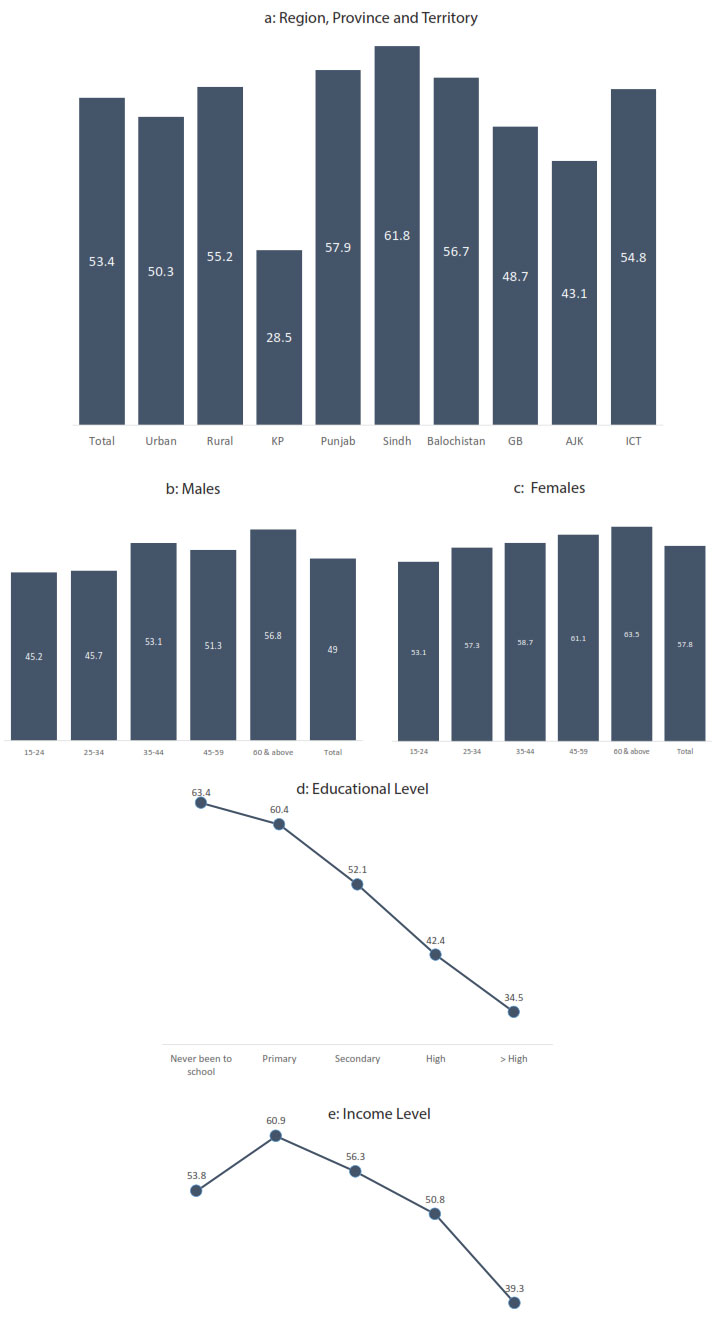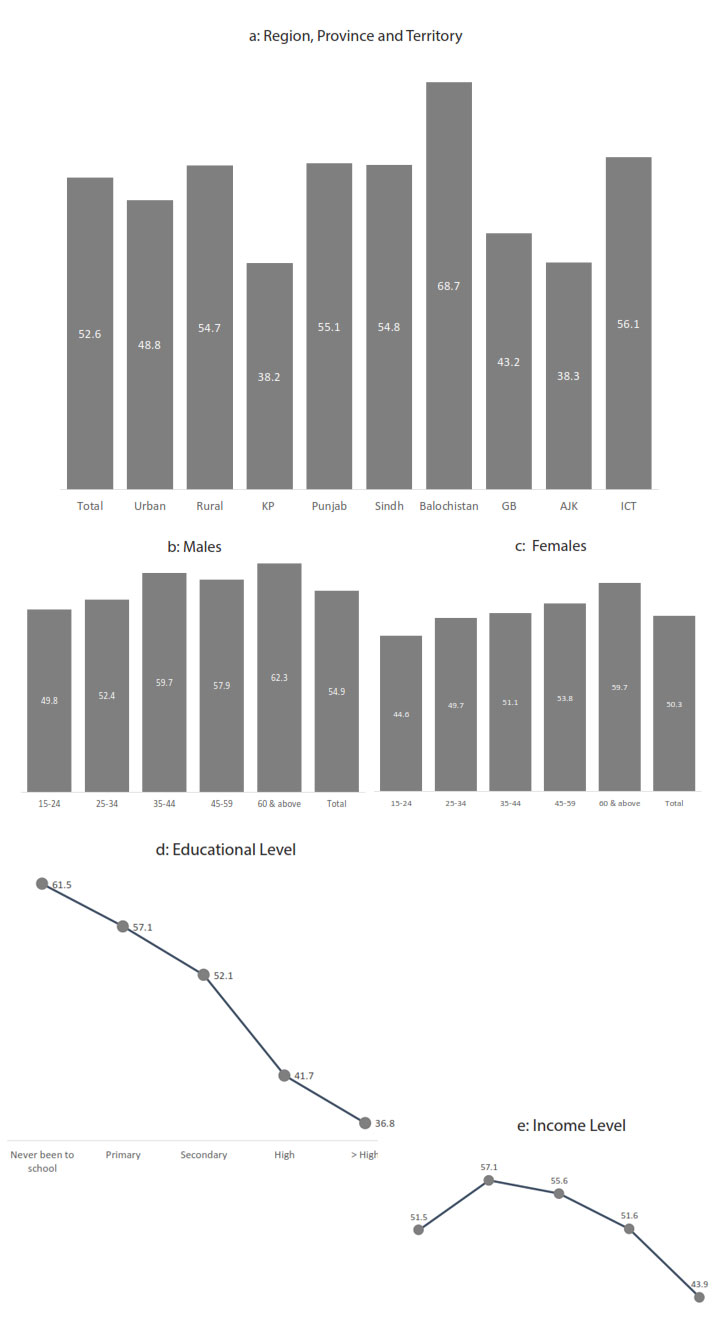A Reflection on Spiritual Beliefs
Although used interchangeably by most, religion and spirituality are not the same. While religion is primarily based on faith, spirituality is more abstract and often relies on experientially validating a belief. The PIDE BASICS Survey looked into some of such spiritual beliefs, the findings of which are presented here.
Belief in Magic
Do Pakistanis believe in magic? Figure 1 shows that near to half of the population has a belief in magic. It may be mentioned here that the survey probed about their belief in different spiritual beliefs, and not them actually practising it.
Figure 1 shows that:
- More people in rural (50.8%) Pakistan, than in urban (45%), believe in magic.
- KP province has the smallest proportion of its population (18.5%) believing in magic while Sindh has the highest (55.7%), with Punjab not lagging far behind (56.5%).
- Among the territories, GB (29.7%) has fewer people who believe in magic, as compared to AJK and ICT.
- No difference is found between the two sexes with regard to having a belief in magic.
- With age, the belief in magic generally increases.
- Increasing educational level reduces the belief in magic, except for the highest education level.
- A counter-intuitive trend is exhibited across income quintiles, with the proportion believing in magic generally increasing with rising income levels.
Figure 1: Proportion having a Belief in Magic (%)

Belief in Visiting Shrines
People can have different ways of finding solace, and visiting shrines is one of these. When questioned about their belief in visiting shrines, the majority of the Pakistanis (52.4%) responded in the affirmative (Figure 2).
Trends, as can be seen in Figure 2, regarding the belief in visiting shrines tell us that:
- No major urban-rural difference is found in the belief in visiting shrines.
- Among the four provinces, people in Sindh (63.8%), followed closely by those in Punjab (60.1%), have the largest proportion believing in visiting shrines. The rate is lowest for the province of KP (15.2%).
- Islamabad Capital Territory (ICT) has the largest segment (65%) believing in visiting shrines, among the three territories.
- Contrary to what one would imagine, a higher proportion of males than females maintain the belief in visiting shrines, and this trend is visible across all ages.
- Belief in shrines declines as we go up the educational ladder.
- Increasing income level, after the second quintile, accompanies a decline in the belief in shrines.
Figure 2: Proportion having Belief in Visiting Shrines (%)

Belief in Mannat
Mannat can be defined as a pledge to God that if a certain wish or prayer gets fulfilled, the person would in return perform a certain act and/or make a sacrifice in cash or kind. When asked about the belief in pledging a mannat, the majority of the Pakistanis (53.4%) in the PIDE BASICS Survey responded in the affirmative.
Trends shown in Figure 3 tell us that:
- More people in rural Pakistan (55.2%) than in urban (50.3%) believe in mannat.
- Sindh (61.8%) again comes out as the province with the strongest belief in pledging mannat, followed closely by Punjab (57.9%) and Balochistan (56.7%).
- People in ICT (54.8%) have a higher proportion believing in mannat than the territories of GB and AJK.
- As opposed to what we saw for the belief in visiting shrines, the belief in mannat is more prevalent among females (57.8%) than males (49%), and the trend generally increases with age for both sexes.
- The belief in mannat declines with increasing education and income levels.
Figure 3: Proportion having a Belief in Mannat1 (%)

Source: Author’s estimation using the PIDE BASICS Survey dataset.
Note: 1. Making a ‘promise’ with Allah that once a wish/prayer is accepted, the person will do something in return, which can be either or both cash and/or kind.
Belief in Amulets
Amulets, locally called taveez, are inscriptions aimed at protecting a person, warding off bad luck and evil spells, and bringing in good luck and fulfilment of wishes. Taveez, generally worn, can also be advised to be kept in peculiar conditions or a particular place. The PIDE BASICS Survey asked people if they believed in the effect and influence of amulets and found more than half the Pakistanis believing in them (see Figure 4).
- Slightly more people in rural areas (54.7%) than urban areas (48.8%) have a belief in amulets.
- As opposed to the above-discussed trends, people in Balochistan (68.7%) have the largest proportion who believe in taveez, followed by those in Punjab (55.1%) and Sindh (54.8%). KP continues to be the province with the smallest proportion having these beliefs.
- Somewhat more males (54.9%) (50.3%) than females believe in amulets, with the trend generally increasing with age for both sexes.
- The belief in amulets declines with increasing education and income levels.
Figure 4: Proportion having a Belief in Amulets (%)

Source: Author’s estimation using the PIDE BASICS Survey dataset.




